Abstract
This study evaluated a possible protective and therapeutic effect of moderate hypothermia in the treatment of severe hemorrhagic shock. A modified Wiggers shock preparation was used. Normothermic dogs (Group I, N = 6) were maintained at normal body temperature throughout hemorrhagic shock and resuscitation. In Group II, hypothermia was initiated after 15 minutes of hemorrhagic shock (N = 12) and maintained for 60 minutes after fluid resuscitation. Animals were then rewarmed with Group IIA (N = 7) receiving sodium bicarbonate to correct acidosis, while Group IIB (N = 5) did not; all dogs were studied for an additional 120 minutes. During shock heart rate was lower in both hypothermic groups (IIA and IIB) compared to normothermic dogs (85.0 +/- 3.9, 77.7 +/- 4.6 vs. 136.7 +/- 4.2, respectively, p less than 0.05), while +dP/dt (mmHg/s) remained stable in all dogs. Furthermore, pH was lower in the hypothermic (Groups IIA and IIB) compared to normothermic animals at this time period (Group IIA: 7.19 +/- 0.02, Group IIB: 7.13 +/- 0.02 vs. Group I: 7.24 +/- 0.02). Arterial pCO2 was higher in the hypothermic hemorrhagic shock Groups IIA and IIB compared to normothermic group (34.5 +/- 2.2, 37.4 +/- 2.2 vs. 20.3 +/- 20,3 +/- 2.0, p less than 0.05) due to hypothermia-depressed respiration. A higher myocardial O2 consumption and a negative myocardial lactate balance occurred in the normothermic animals during hemorrhagic shock. After resuscitation and rewarming, stroke volume (mL/beat) and cardiac output (L/min) were lower in hypothermic animals with persistent acid-base derangements (12.6 +/- 2.5, 1.3 +/- 3.0, respectively) compared to hypothermic dogs with acid-base correction (20.1 +/- 3.3, 2.2 +/- 0.3) and normothermic dogs (24.6 +/- 3.0, 3.0 +/- 0.3, p less than 0.05), while myocardial O2 extraction and myocardial lactate production were higher. Results suggest hypothermia decreases the metabolic needs and maintains myocardial contractile function in hemorrhagic shock. Hypothermia may have a beneficial effect and, with normalization of acid-base balance, a therapeutic role in hemorrhagic shock.
Full text
PDF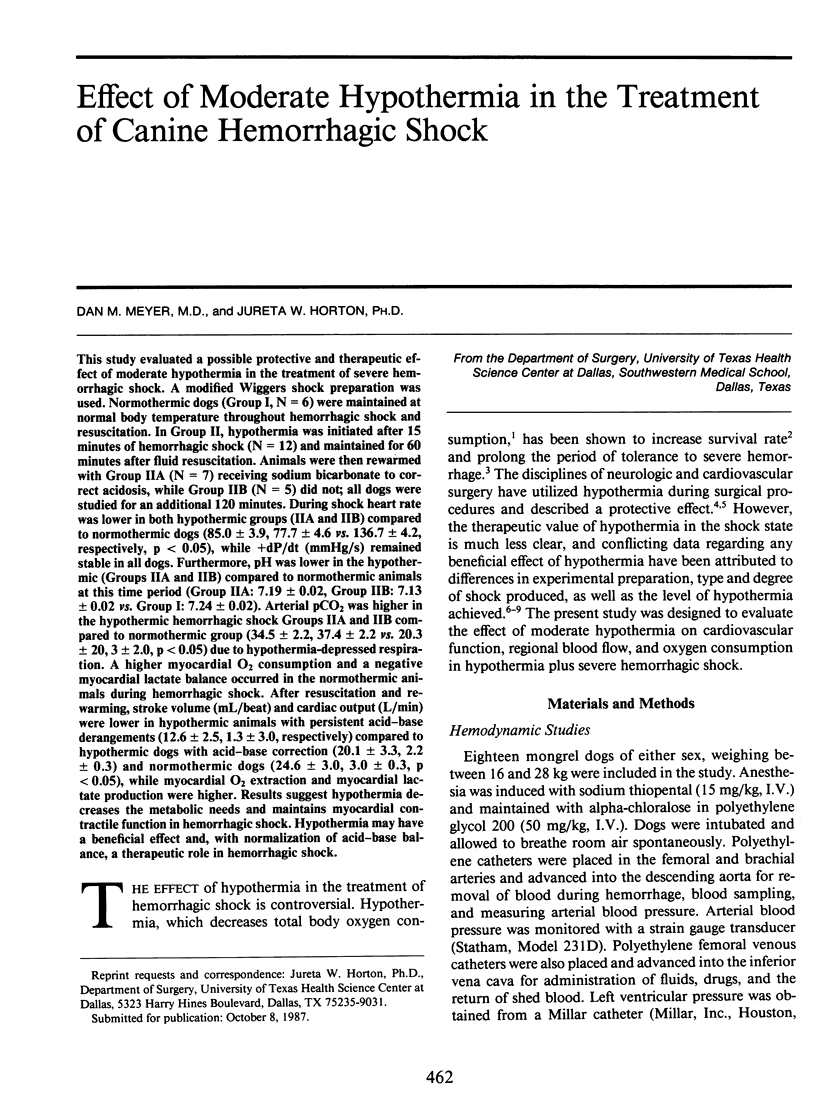
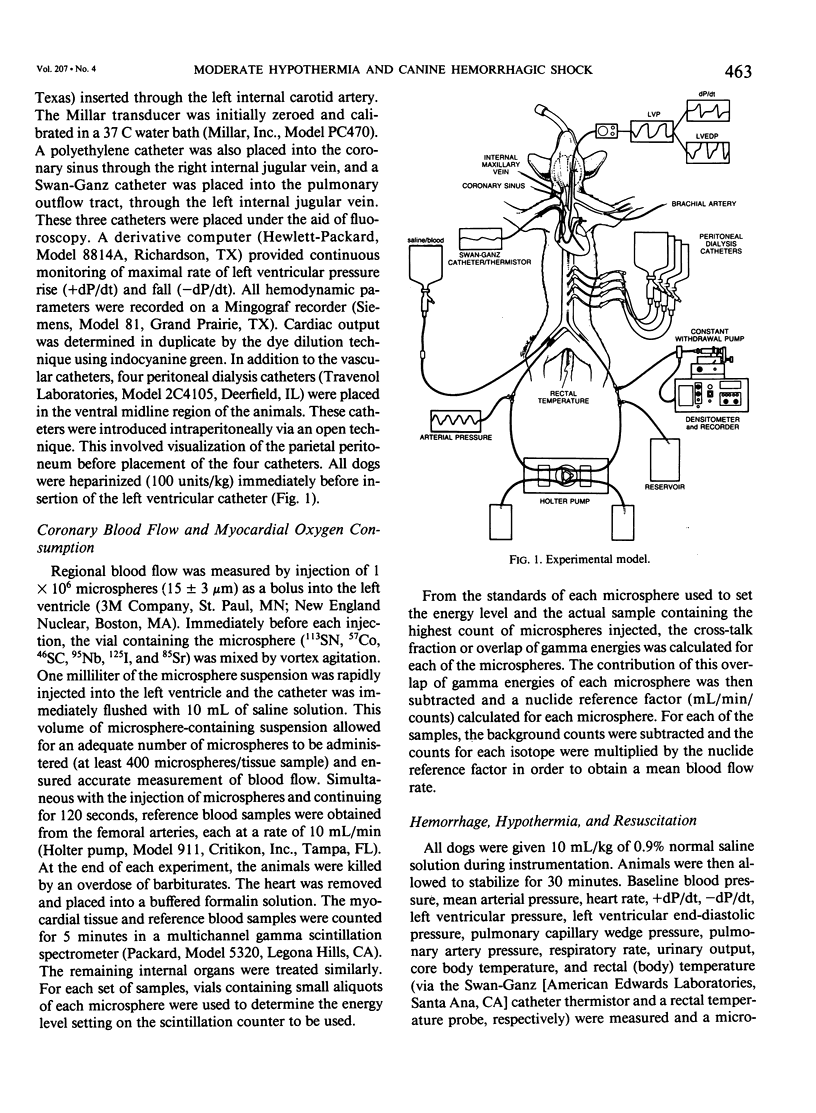

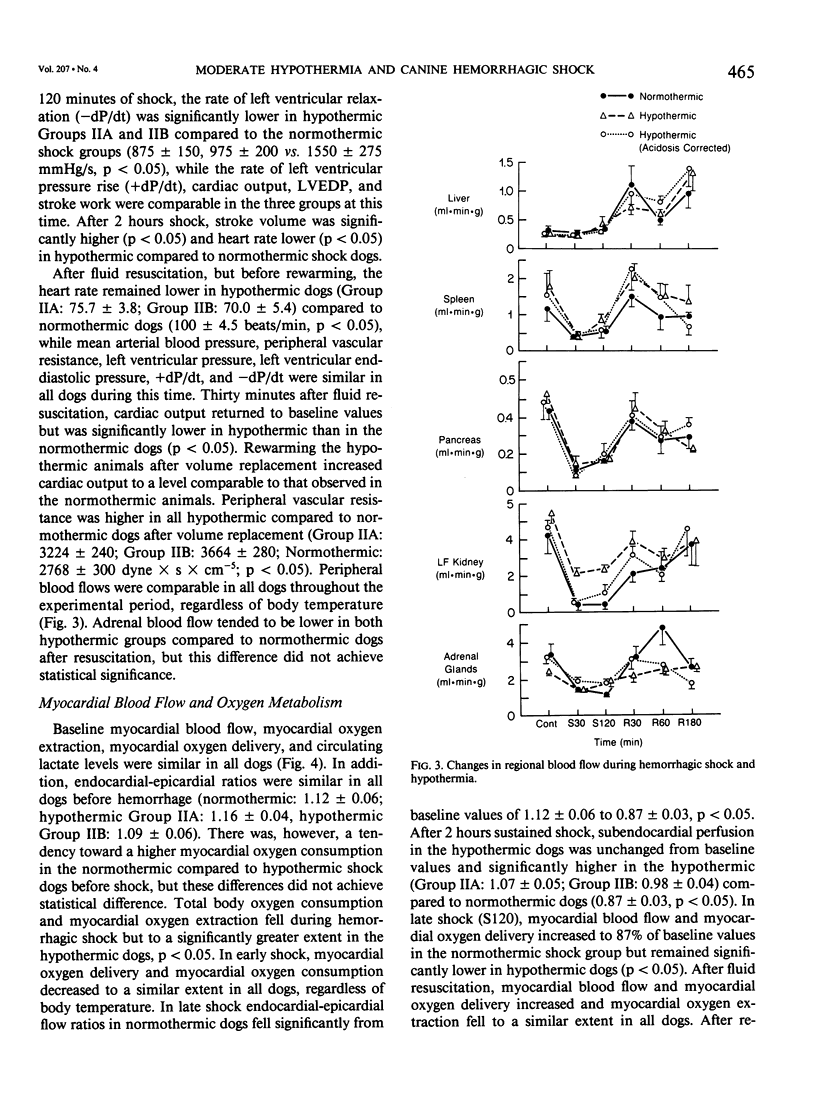
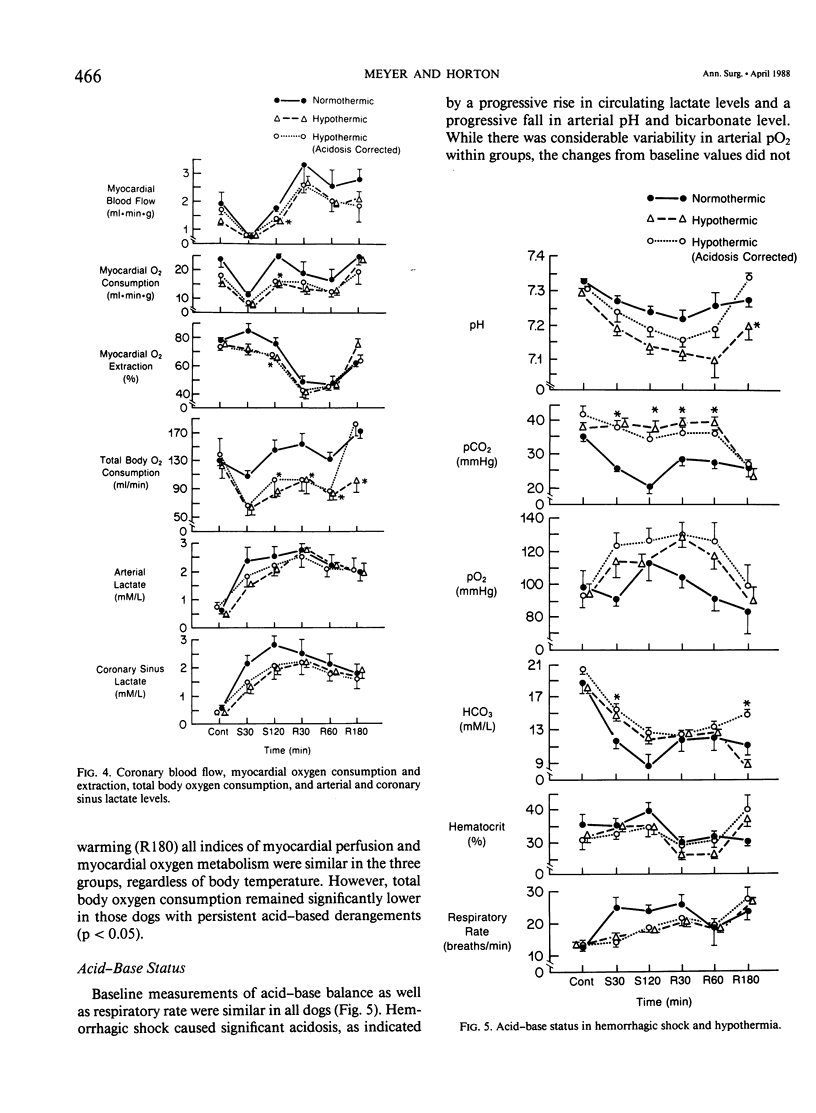
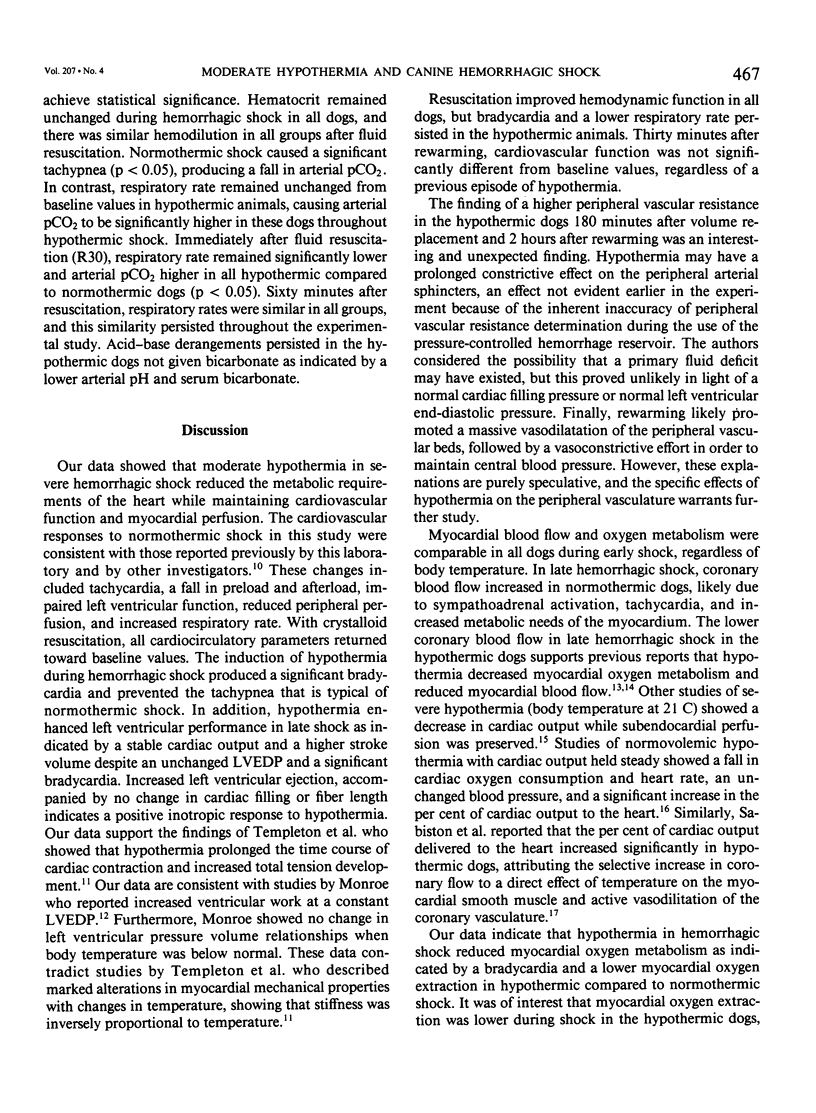

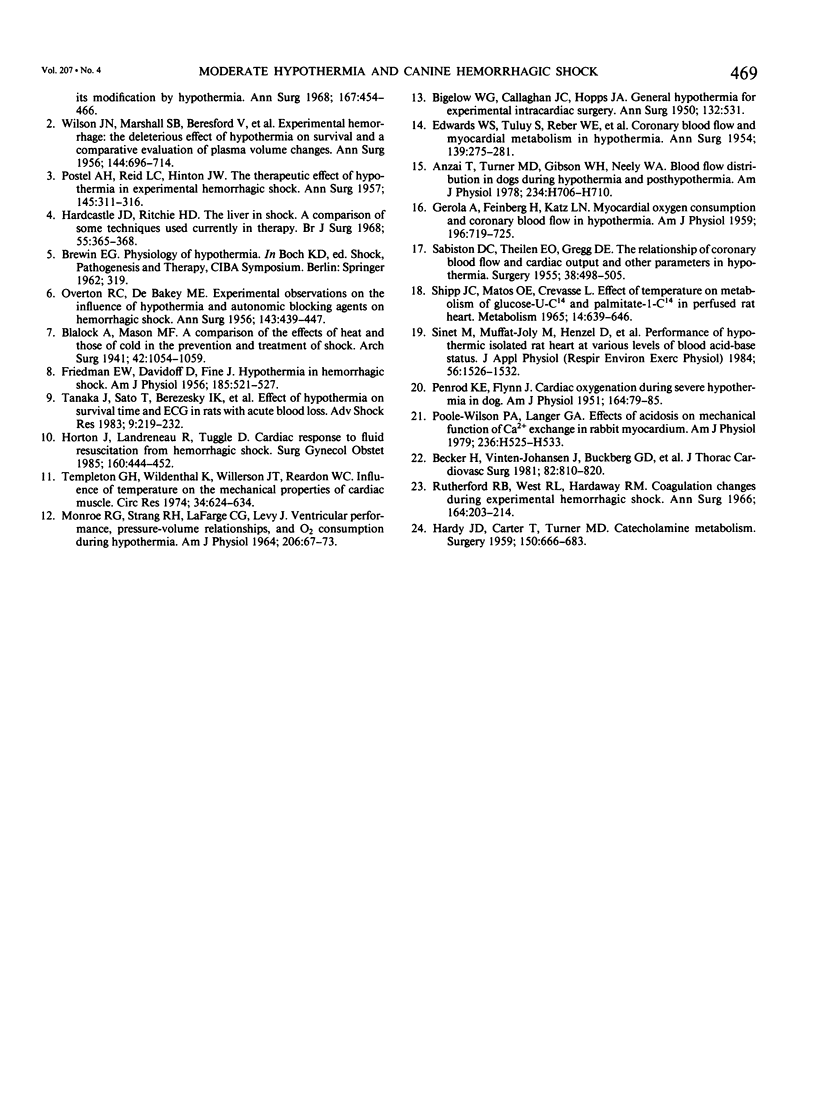
Selected References
These references are in PubMed. This may not be the complete list of references from this article.
- Anzai T., Turner M. D., Gibson W. H., Neely W. A. Blood flow distribution in dogs during hypothermia and posthypothermia. Am J Physiol. 1978 Jun;234(6):H706–H710. doi: 10.1152/ajpheart.1978.234.6.H706. [DOI] [PubMed] [Google Scholar]
- BERESFORD V., JENKINS D., MARSHALL S. B., MONTGOMERY V., SWAN H., WILSON J. N. Experimental hemorrhage: the deleterious effect of hypothermia on survival and a comparative evaluation of plasma volume changes. Ann Surg. 1956 Oct;144(4):696–714. doi: 10.1097/00000658-195610000-00012. [DOI] [PMC free article] [PubMed] [Google Scholar]
- BIGELOW W. G., CALLAGHAN J. C., HOPPS J. A. General hypothermia for experimental intracardiac surgery; the use of electrophrenic respirations, an artificial pacemaker for cardiac standstill and radio-frequency rewarming in general hypothermia. Ann Surg. 1950 Sep;132(3):531–539. doi: 10.1097/00000658-195009000-00018. [DOI] [PMC free article] [PubMed] [Google Scholar]
- Becker H., Vinten-Johansen J., Buckberg G. D., Robertson J. M., Leaf J. D., Lazar H. L., Manganaro A. J. Myocardial damage caused by keeping pH 7.40 during systemic deep hypothermia. J Thorac Cardiovasc Surg. 1981 Dec;82(6):810–821. [PubMed] [Google Scholar]
- EDWARDS W. S., TULUY S., REBER W. E., SIEGEL A., BING R. J. Coronary blood flow and myocardial metabolism in hypothermia. Ann Surg. 1954 Mar;139(3):275–281. doi: 10.1097/00000658-195403000-00003. [DOI] [PMC free article] [PubMed] [Google Scholar]
- FRIEDMAN E. W., DAVIDOFF D., FINE J. Hypothermia in hemorrhagic shock. Am J Physiol. 1956 Jun;185(3):521–527. doi: 10.1152/ajplegacy.1956.185.3.521. [DOI] [PubMed] [Google Scholar]
- GEROLA A., FEINBERG H., KATZ L. N. Myocardial oxygen consumption and coronary blood flow in hypothermia. Am J Physiol. 1959 Apr;196(4):719–725. doi: 10.1152/ajplegacy.1959.196.4.719. [DOI] [PubMed] [Google Scholar]
- HARDY J. D., CARTER T., TURNER M. D. Catechol amine metabolism: peripheral plasma levels of epinephrine (E) and norepinephrine (NE) during laparotomy under different types of anesthesia in dogs, during operation in man (including adrenal vein sampling), and before and following resection of a pheochromocytoma associated with von Recklinghausen's neurofibromatosis. Ann Surg. 1959 Oct;150:666–683. doi: 10.1097/00000658-195910000-00011. [DOI] [PMC free article] [PubMed] [Google Scholar]
- Hardcastle J. D., Ritchie H. D. The liver in shock. A comparison of some techniques used currently in therapy. Br J Surg. 1968 May;55(5):365–368. doi: 10.1002/bjs.1800550509. [DOI] [PubMed] [Google Scholar]
- Horton J., Landreneau R., Tuggle D. Cardiac response to fluid resuscitation from hemorrhagic shock. Surg Gynecol Obstet. 1985 May;160(5):444–452. [PubMed] [Google Scholar]
- MONROE R. G., STRANG R. H., LAFARGE C. G., LEVY J. VENTRICULAR PERFORMANCE, PRESSURE-VOLUME RELATIONSHIPS, AND O2 CONSUMPTION DURING HYPOTHERMIA. Am J Physiol. 1964 Jan;206:67–73. doi: 10.1152/ajplegacy.1964.206.1.67. [DOI] [PubMed] [Google Scholar]
- OVERTON R. C., DE BAKEY M. E. Experimental observations on the influence of hypothermia and autonomic blocking agents on hemorrhagic shock. Ann Surg. 1956 Apr;143(4):439–447. doi: 10.1097/00000658-195604000-00002. [DOI] [PMC free article] [PubMed] [Google Scholar]
- PENROD K. E., FLYNN J. Cardiac oxygenation during severe hypothermia in dog. Am J Physiol. 1951 Jan;164(1):79–85. doi: 10.1152/ajplegacy.1950.164.1.79. [DOI] [PubMed] [Google Scholar]
- POSTEL A. H., REID L. C., HINTON J. W. The therapeutic effect of hypothermia in experimental hemorrhagic shock. Ann Surg. 1957 Mar;145(3):311–316. doi: 10.1097/00000658-195703000-00003. [DOI] [PMC free article] [PubMed] [Google Scholar]
- Poole-Wilson P. A., Langer G. A. Effects of acidosis on mechanical function and Ca2+ exchange in rabbit myocardium. Am J Physiol. 1979 Apr;236(4):H525–H533. doi: 10.1152/ajpheart.1979.236.4.H525. [DOI] [PubMed] [Google Scholar]
- Race D., Cooper E., Rosenbaum M. Hemorrhagic shock: the effect of prolonged low flow on the regional distribution of blood and its modification by hypothermia. Ann Surg. 1968 Apr;167(4):454–466. doi: 10.1097/00000658-196804000-00002. [DOI] [PMC free article] [PubMed] [Google Scholar]
- Rutherford R. B., West R. L., Hardaway R. M., 3rd Coagulation changes during experimental hemorrhagic shock. Clotting activity, contribution of splanchnic circulation and acidosis as controlled by THAM. Ann Surg. 1966 Aug;164(2):203–214. doi: 10.1097/00000658-196608000-00004. [DOI] [PMC free article] [PubMed] [Google Scholar]
- SABISTON D. C., Jr, THEILEN E. O., GREGG D. E. The relationship of coronary blood flow and cardiac output and other parameters in hypothermia. Surgery. 1955 Sep;38(3):498–505. [PubMed] [Google Scholar]
- SHIPP J. C., MATOS O. E., CREVASSE L. EFFECT OF TEMPERATURE ON METABOLISM OF GLUCOSE-U-C-14 AND PALMITATE-1-C-14 IN PERFUSED RAT HEART. Metabolism. 1965 May;14:639–646. doi: 10.1016/s0026-0495(65)80027-0. [DOI] [PubMed] [Google Scholar]
- Sinet M., Muffat-Joly M., Henzel D., Renault G., Pocidalo J. J. Performance of hypothermic isolated rat heart at various levels of blood acid-base status. J Appl Physiol Respir Environ Exerc Physiol. 1984 Jun;56(6):1526–1532. doi: 10.1152/jappl.1984.56.6.1526. [DOI] [PubMed] [Google Scholar]
- Tanaka J., Sato T., Berezesky I. K., Jones R. T., Trump B. F., Cowley R. A. Effect of hypothermia on survival time and ECG in rats with acute blood loss. Adv Shock Res. 1983;9:219–232. [PubMed] [Google Scholar]
- Templeton G. H., Wildenthal K., Willerson J. T., Reardon W. C. Influence of temperature on the mechanical properties of cardiac muscle. Circ Res. 1974 May;34(5):624–634. doi: 10.1161/01.res.34.5.624. [DOI] [PubMed] [Google Scholar]


